Imagine harvesting sweet, juicy pears from your own backyard, even if you only have a tiny patio or balcony! A dwarf pear tree is the perfect solution for small-space gardeners dreaming of homegrown fruit. Compact, low-maintenance, and bursting with delicious pears, these trees are a game-changer for urban gardeners and beginners alike. Whether you’re new to gardening or a seasoned grower, this comprehensive guide will walk you through every step to ensure your dwarf pear tree thrives. Backed by horticultural expertise and practical insights, you’ll learn how to plant, care for, and harvest from your tree with confidence. Let’s dive into the world of dwarf pear trees and unlock their full potential! 🌱
1. What is a Dwarf Pear Tree? 🌿
1.1 Definition and Characteristics
A dwarf pear tree is a compact version of a standard pear tree, bred to grow to a manageable height of 6–8 feet. Unlike their larger counterparts, which can soar to 20 feet or more, dwarf pear trees are ideal for small gardens, patios, or even large containers. Despite their size, they produce full-sized, flavorful pears, making them a favorite among home gardeners. Their smaller stature means easier pruning, harvesting, and maintenance, perfect for those with limited space or time.
These trees are typically grafted onto dwarfing rootstocks, which control their size while maintaining robust fruit production. They thrive in a variety of climates, particularly USDA hardiness zones 5–9, and offer the same beautiful spring blossoms and vibrant fall foliage as standard pear trees.
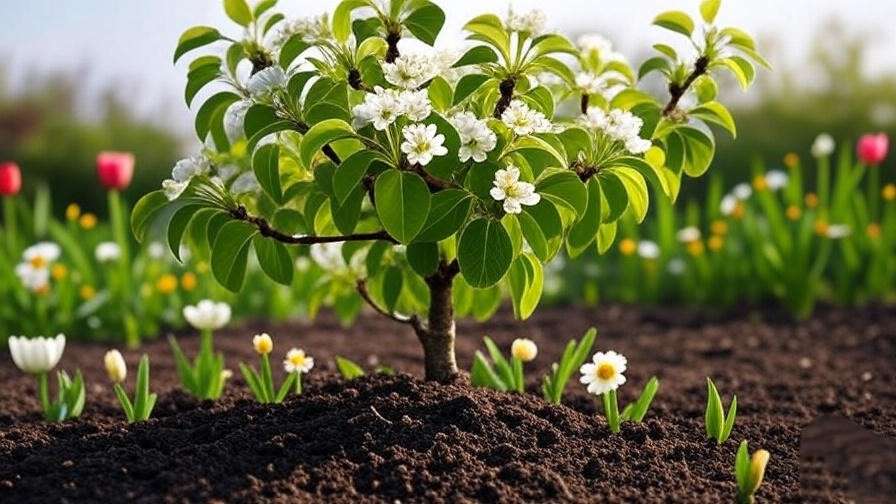
1.2 Popular Varieties of Dwarf Pear Trees
Choosing the right variety is key to success. Here are some popular dwarf pear tree varieties:
- Bartlett: Known for its sweet, juicy yellow pears, ideal for fresh eating or canning. Ripens mid-season.
- Moonglow: A disease-resistant variety with soft, mildly sweet fruit. Great for cooler climates.
- Seckel: Produces small, caramel-sweet pears, perfect for snacking or preserves. Late-season ripener.
Expert Tip: Check your USDA zone (available via the USDA Plant Hardiness Zone Map) to select a variety suited to your climate. For example, ‘Moonglow’ excels in colder zones, while ‘Bartlett’ thrives in milder regions.
2. Why Choose a Dwarf Pear Tree? 🌞
2.1 Benefits for Small Spaces
Dwarf pear trees are a dream come true for urban gardeners. Their compact size fits perfectly in small yards, balconies, or even large pots, making them versatile for any space. Unlike standard fruit trees, they don’t require sprawling acreage, yet they still yield an impressive harvest—often 20–50 pounds of fruit per season for a mature tree. Plus, their smaller canopy simplifies tasks like pruning and pest control, saving you time and effort.
2.2 Aesthetic and Functional Value
Beyond their fruit, dwarf pear trees add beauty to any landscape. In spring, they burst into clouds of white or pink blossoms, attracting pollinators like bees and butterflies. In fall, their leaves turn vibrant shades of red and orange, creating a stunning display. Functionally, they provide fresh, organic pears for smoothies, desserts, or jams, reducing your grocery bill and environmental footprint. Growing your own fruit also supports local ecosystems by fostering biodiversity.
3. Planting Your Dwarf Pear Tree: Step-by-Step Guide 🌱
3.1 Choosing the Right Location
Location is critical for a thriving dwarf pear tree. These trees need:
- Sunlight: At least 6–8 hours of direct sunlight daily for optimal growth and fruit production.
- Soil: Well-draining, loamy soil with a pH of 6.0–7.0. Test your soil with a home kit or send a sample to your local extension service.
- Space: Ensure enough room for root growth (about 6–8 feet for in-ground planting) or a large container (at least 15–20 gallons) for potted trees.
Avoid low-lying areas where cold air or water might pool, as this can harm roots or invite frost damage.
3.2 When and How to Plant
The best times to plant a dwarf pear tree are early spring or fall, when temperatures are mild, and the tree can establish roots before extreme weather. Follow these steps:
- Prepare the Site: Dig a hole twice as wide and as deep as the root ball. Mix compost or aged manure into the soil for added nutrients.
- Plant the Tree: Place the tree in the hole, ensuring the graft union (the bulge where the rootstock meets the trunk) is 2–3 inches above ground. Spread roots gently.
- Backfill and Water: Fill the hole with soil, tamping down to remove air pockets. Water deeply to settle the soil.
- Stake if Needed: Use a stake to support young trees against wind, especially in exposed areas.
Expert Insight: Staking prevents root disturbance and promotes straight growth. Remove stakes after the first year to encourage natural strength.
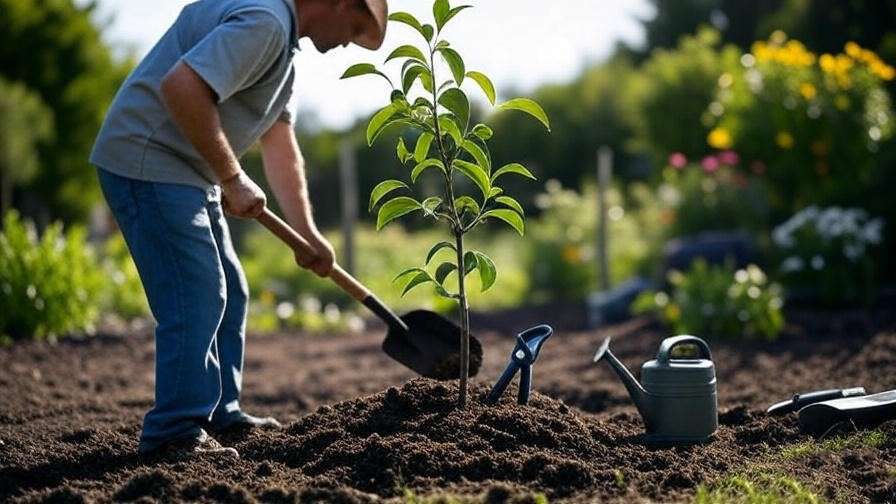
3.3 Container Planting Tips
For urban gardeners, growing a dwarf pear tree in a container is a fantastic option. Choose a pot with drainage holes, at least 18–24 inches in diameter. Use a high-quality potting mix with perlite or vermiculite for drainage. Place the pot in a sunny spot and water regularly, ensuring the soil stays moist but not soggy. Repot every 2–3 years to refresh nutrients and prevent root-binding.
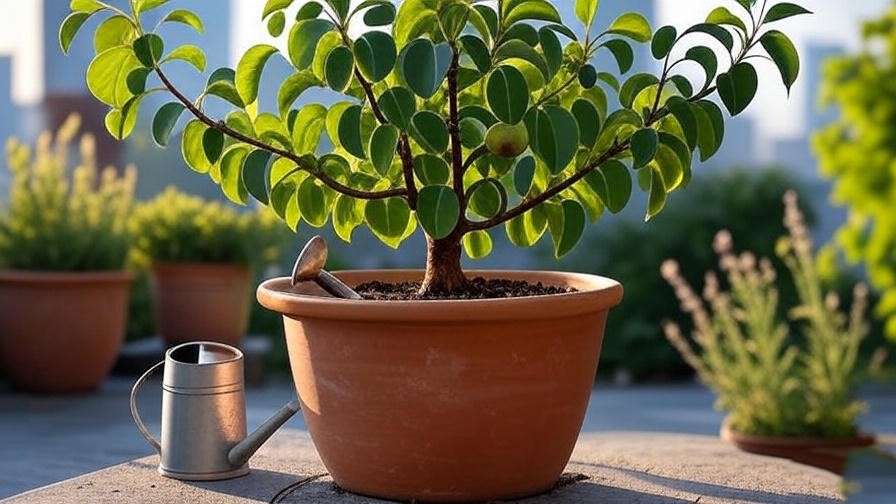
4. Essential Care Tips for a Thriving Dwarf Pear Tree 🌼
4.1 Watering Needs
Proper watering is crucial for healthy growth. Newly planted trees need deep watering (about 1–2 inches per week) to establish roots. Mature trees are more drought-tolerant but still require consistent moisture, especially during fruit development. Use a soaker hose or drip irrigation to deliver water directly to the root zone. Avoid overhead watering to prevent fungal issues.
Common Mistake: Overwatering can lead to root rot. Check soil moisture by digging 2–3 inches down; water only if the soil feels dry.
4.2 Fertilizing for Optimal Growth
Fertilize your dwarf pear tree to boost growth and fruit production. Use a balanced fertilizer (e.g., 10-10-10 NPK) or an organic option like composted manure. Apply in early spring as buds swell and again in mid-summer after fruit sets. Spread fertilizer evenly around the drip line (the area under the canopy), avoiding direct contact with the trunk.
Warning: Over-fertilizing can cause excessive leaf growth at the expense of fruit. If leaves turn dark green and fruit production drops, reduce fertilizer and test soil nutrients.
4.3 Pruning for Health and Yield
Pruning shapes your tree, improves airflow, and boosts fruit quality. Prune in late winter or early spring while the tree is dormant. Follow these steps:
- Remove Dead Wood: Cut away any dead, damaged, or diseased branches.
- Thin the Canopy: Remove crowded branches to allow sunlight and air to reach the center.
- Shape the Tree: Maintain an open-center or vase shape to encourage fruiting spurs.
Use clean, sharp pruning shears to prevent disease. Disinfect tools with rubbing alcohol between cuts.
Expert Tip: Focus on removing vertical “water sprouts” and suckers at the base, as they divert energy from fruit production.
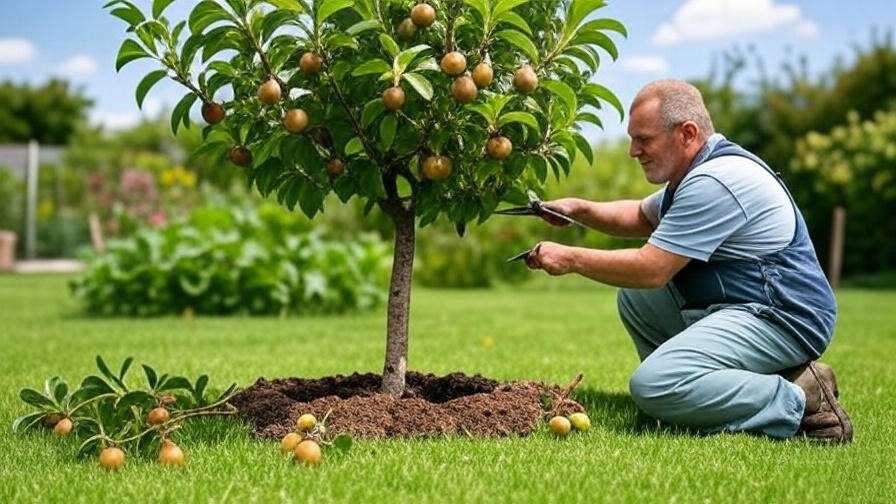
4.4 Pollination Requirements
Some dwarf pear trees are self-pollinating (e.g., ‘Bartlett’), while others (e.g., ‘Seckel’) require a second tree for cross-pollination. If you have a non-self-pollinating variety, plant another compatible pear tree within 50 feet or rely on nearby pollinators like bees. For urban settings with limited pollinators, try hand-pollination:
- Collect pollen from one tree’s blossoms using a small brush.
- Transfer pollen to the stigma of another tree’s flowers.
- Repeat during peak bloom for best results.
5. Common Pests and Diseases: Prevention and Treatment 🐛
5.1 Identifying Common Pests
Dwarf pear trees face a few common pests, but early detection and organic controls can keep them in check:
- Aphids: Tiny insects that suck sap, causing curled leaves. Spray with neem oil or introduce ladybugs.
- Pear Psylla: Small, winged pests that damage buds. Use insecticidal soap and prune affected areas.
- Codling Moths: Larvae bore into fruit. Set pheromone traps and remove fallen fruit to break their life cycle.
Encourage natural predators like birds and beneficial insects by planting companion plants like marigolds or yarrow.
5.2 Managing Diseases
Dwarf pear trees are susceptible to diseases, but proactive care minimizes risks:
- Fire Blight: A bacterial disease causing blackened, wilted shoots. Prune affected areas 12 inches below symptoms and disinfect tools. Choose resistant varieties like ‘Moonglow.’
- Pear Scab: Fungal spots on leaves and fruit. Apply sulfur-based fungicides in early spring and remove fallen leaves.
- Powdery Mildew: White coating on leaves. Improve airflow through pruning and apply organic fungicides.
Expert Insight: Plant resistant varieties in humid climates and maintain good sanitation by clearing debris around the tree.
5.3 Seasonal Maintenance Checklist
- Spring: Fertilize, prune, and monitor for pests. Apply mulch to retain moisture.
- Summer: Water consistently, check for diseases, and thin young fruit to improve quality.
- Fall/Winter: Rake fallen leaves, mulch the base, and wrap trunks in cold climates to protect from frost.
6. Harvesting and Enjoying Your Dwarf Pear Tree’s Fruit 🍐
6.1 When to Harvest
Timing is everything when harvesting pears from your dwarf pear tree. Unlike apples, pears are best picked slightly underripe and allowed to ripen off the tree for optimal flavor and texture. Look for these signs of readiness:
- Color Change: The fruit’s skin shifts from green to its mature color (yellow for ‘Bartlett,’ reddish-brown for ‘Seckel’).
- Firmness: Pears should feel firm but yield slightly to gentle pressure near the stem.
- Ease of Picking: Tilt the pear upward; if it detaches easily from the branch, it’s ready.
Harvest times vary by variety:
- Early-season (e.g., ‘Bartlett’): Late summer (July–August).
- Mid-season (e.g., ‘Moonglow’): August–September.
- Late-season (e.g., ‘Seckel’): September–October.
Use pruning shears or gently twist the fruit to avoid damaging the tree or spurs, which will produce next year’s fruit.
Expert Tip: Check a few pears for taste. If they’re sweet but still firm, start harvesting to prevent overripening on the tree.
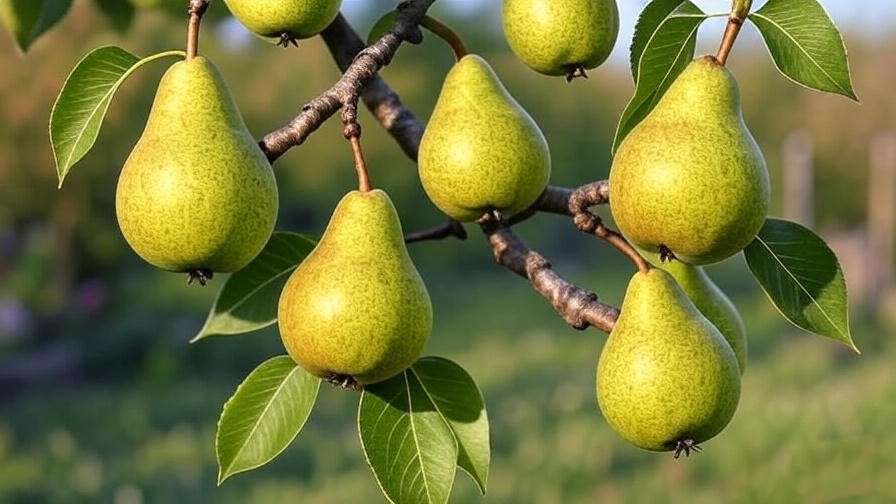
6.2 Storing and Using Your Pears
Proper storage extends the life of your harvest. Store pears in a cool, humid environment (30–35°F, like a refrigerator crisper) to keep them fresh for 1–3 months. Wrap each pear in newspaper to prevent bruising and check weekly for ripeness by pressing near the stem.
Dwarf pear tree fruit is versatile for culinary use:
- Fresh Eating: Slice ‘Bartlett’ or ‘Seckel’ pears for a sweet, juicy snack.
- Cooking and Baking: Use in pies, tarts, or poached pear desserts. Try a classic pear and almond tart recipe.
- Preserving: Make pear jam, chutney, or canned slices for year-round enjoyment.
Recipe Idea: For a simple pear salad, toss sliced pears with arugula, walnuts, goat cheese, and a balsamic vinaigrette. This showcases the fruit’s natural sweetness and pairs well with savory flavors.
Expert Tip: To speed up ripening, place pears in a paper bag with an apple or banana, which releases ethylene gas. Check daily to avoid overripening.
7. Troubleshooting Common Problems 🔧
Even with the best care, dwarf pear trees may face challenges. Here’s how to diagnose and fix common issues to keep your tree thriving.
7.1 Why Isn’t My Tree Fruiting?
If your dwarf pear tree isn’t producing fruit, consider these potential causes:
- Poor Pollination: Non-self-pollinating varieties need a compatible tree nearby or sufficient pollinators. Ensure bees have access or try hand-pollination (see Section 4.4).
- Nutrient Imbalance: Over-fertilizing with nitrogen can lead to lush foliage but no fruit. Switch to a low-nitrogen, high-phosphorus fertilizer (e.g., 5-10-10) to encourage blooming.
- Improper Pruning: Cutting fruiting spurs can reduce yield. Focus pruning on dead or crowded branches and preserve short, stubby spurs where pears form.
- Young Tree: Most dwarf pear trees take 2–3 years to bear fruit. Be patient and ensure proper care.
Solution: Test soil nutrients, verify pollination needs, and adjust pruning techniques. If issues persist, consult a local extension service for tailored advice.
7.2 Yellowing Leaves or Stunted Growth
Yellow leaves or slow growth often signal environmental or nutritional issues:
- Nutrient Deficiency: Yellowing leaves may indicate a lack of nitrogen, iron, or magnesium. Apply a balanced fertilizer or chelated iron for quick correction.
- Overwatering: Soggy soil suffocates roots, causing yellowing or wilting. Ensure proper drainage and water only when the top 2–3 inches of soil are dry.
- Root Issues: Compacted or bound roots (common in containers) stunt growth. For potted trees, repot every 2–3 years; for in-ground trees, check for girdling roots.
Solution: Conduct a soil test to pinpoint deficiencies, improve drainage, and inspect roots during repotting or early spring maintenance.
7.3 Winter Protection for Dwarf Pear Trees
Cold climates can stress dwarf pear trees, especially young ones. Protect them with these steps:
- Mulching: Apply a 2–4-inch layer of organic mulch (e.g., wood chips or straw) around the base, keeping it 2 inches from the trunk to prevent rot.
- Wrapping: Wrap the trunk with burlap or tree wrap to shield against frost cracks and rodent damage.
- Container Care: Move potted trees to a sheltered area (e.g., a garage) during extreme cold, or insulate pots with bubble wrap.
Expert Insight: In zones colder than 5, choose hardy varieties like ‘Moonglow’ and avoid late-season fertilization, which can stimulate tender growth vulnerable to frost.
8. FAQs: Your Dwarf Pear Tree Questions Answered ❓
Here are answers to common questions to help you succeed with your dwarf pear tree:
- How long does it take for a dwarf pear tree to bear fruit?
Most dwarf pear trees produce fruit within 2–3 years if properly cared for. Ensure adequate pollination and avoid over-pruning to speed up fruiting. - Can I grow a dwarf pear tree indoors?
Growing indoors is challenging due to limited sunlight and space. Instead, place a potted tree on a sunny patio or balcony. If indoors, use grow lights (12–16 hours daily) and a large container. - Do dwarf pear trees need a second tree for pollination?
It depends on the variety. Self-pollinating trees like ‘Bartlett’ don’t require a second tree, but cross-pollinating varieties like ‘Seckel’ benefit from a compatible tree nearby. - How much fruit can I expect from a dwarf pear tree?
A mature tree (3–5 years old) can yield 20–50 pounds of fruit per season, depending on variety, care, and climate. - What’s the lifespan of a dwarf pear tree?
With proper care, dwarf pear trees can live 15–20 years, producing fruit reliably for most of that time.
9. Conclusion: Your Path to a Thriving Dwarf Pear Tree 🌟
Growing a dwarf pear tree is a rewarding journey that brings beauty, flavor, and sustainability to your garden. By choosing the right variety, planting in a sunny, well-drained spot, and following a consistent care routine—watering, fertilizing, pruning, and pest management—you’ll enjoy bountiful harvests for years to come. Whether you’re a beginner or an experienced gardener, these expert-backed tips ensure your tree thrives in any small space.
Start your dwarf pear tree adventure today! Share your progress in the comments, ask questions, or explore related articles like “Best Companion Plants for Fruit Trees” for more inspiration. With a little care and patience, your dwarf pear tree will become a fruitful centerpiece in your garden. Happy growing up! 🌳🍐













